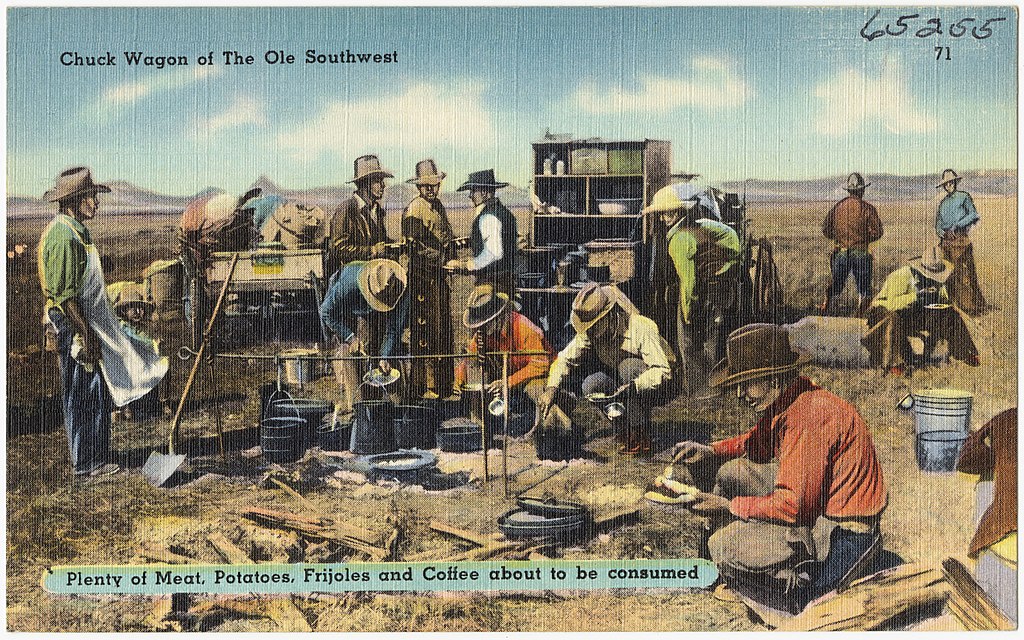Tichnor Bros. postcard circa 1940 with the caption “Chuck Wagon of The Ole Southwest, Plenty of Meat, Potatoes, Frijoles and Coffee about to be consumed”.
There is no life without water. Because water is needed to make coffee.” — Unknown
Coffee is one of the most popular beverages in the world today, but it has a long and fascinating history. The origins of coffee are shrouded in myths and legends, but some historical evidence suggests that coffee was first discovered and cultivated in Ethiopia around 500 AD. According to one popular story, a shepherd named Kaldi noticed that his goats became more energetic after eating the red berries of a wild plant. He tried some himself and felt the same effect. The plant was later identified as Coffea, and its berries contained the seeds that we now call coffee beans.
Coffee plants were mainly grown in the region of Kaffa, which may have given rise to the name of the beverage. From Ethiopia, coffee spread to the Arabian Peninsula, where it was first brewed and consumed by Sufi monks in the 15th century. Coffee then reached Persia, Egypt, Syria, and Turkey, where it became a popular drink and a social phenomenon. Coffee houses, or qahveh khanehs, emerged as places of learning, entertainment, and political debate.
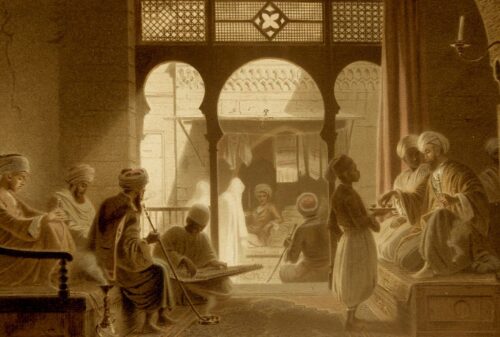
Colonial America
Coffee was introduced to North America by European colonists in the 17th century, but it was not until the 18th century that it gained popularity among Americans. One of the reasons for this was the political and economic conflict with Britain, which imposed heavy taxes on tea, the preferred drink of the British Empire. In 1773, a group of patriots in Boston protested against the Tea Act by dumping chests of tea into the harbor, an event known as the Boston Tea Party. This act of defiance sparked the American Revolution, and coffee became a symbol of patriotism and resistance to tyranny.
John Adams, one of the Founding Fathers and the second President of the United States, wrote to his wife Abigail in 1774: “I believe I forgot to tell you one Anecdote: When I first came to this House it was late in the Afternoon, and I had ridden 35 miles at least. ‘Madam’ said I to Mrs. Huston, ‘is it lawfull [sic] for a weary Traveller [sic] to refresh himself with a Dish of Tea provided it has been honestly smuggled, or paid no Duties?’ ‘No sir, said she, we have renounced all Tea in this Place. I cant make Tea, but I’le [sic] make you Coffee.’ Accordingly I have drank Coffee every Afternoon since, and have borne it very well. Tea must be universally renounced. I must be weaned, and the sooner, the better.”
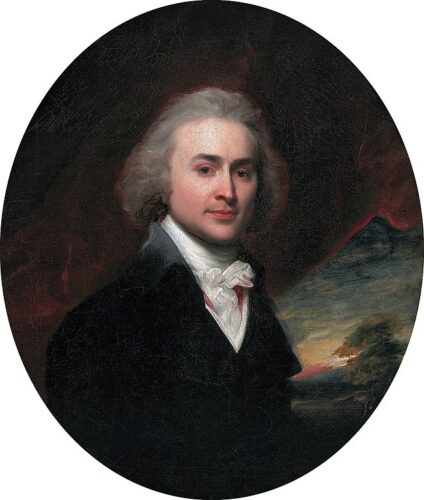
Coffee was one of the most valuable commodities in colonial America, and its demand increased rapidly as more people adopted it as their preferred drink. Coffee beans were imported from various regions such as the Caribbean, South America and Africa, creating a complex network of trade relations that benefited the colonial merchants and farmers. Coffee also stimulated the development of local industries such as roasting, grinding and brewing, which created jobs and income for many colonists. Coffee also contributed to the financing of the war effort, as some of the profits from coffee sales were used to support the Continental Army and Navy.
After the American Revolution
After the Revolutionary War, Americans continued to favor coffee over tea, and coffee houses became places where political and social discussions took place. Coffee also had a stimulating effect on the mind and body, which suited the adventurous spirit of the Americans who wanted to explore and expand their new nation.
Coffee was also widely available and affordable, thanks to the large-scale importation of coffee beans from Brazil and other Latin American countries through the port of New Orleans, which became the second largest importer of coffee in the United States by 1840.
Coffee was also part of the daily rations for the U.S. Army since 1832, when President Andrew Jackson substituted coffee and sugar for rum and brandy, citing complaints from military officers of insubordination and accidental injuries from overindulgence. Coffee gave soldiers a boost of energy and focus, as well as a sense of camaraderie and discipline. As one soldier wrote in his diary: “Coffee is everything to us. We can make a meal on coffee when we have nothing else.” The Army Cavalry relied on coffee to keep them alert and energized during their long patrols.
The Civil War.
Coffee played a significant role during the Civil War. At the outbreak of the Civil War, the United State. imported over 182 million pounds of coffee, with New Orleans distributing beans both throughout the Southern states and into New England. However, this large-scale importation of coffee into New Orleans changed as Southern states seceded from the Union in April of 1861
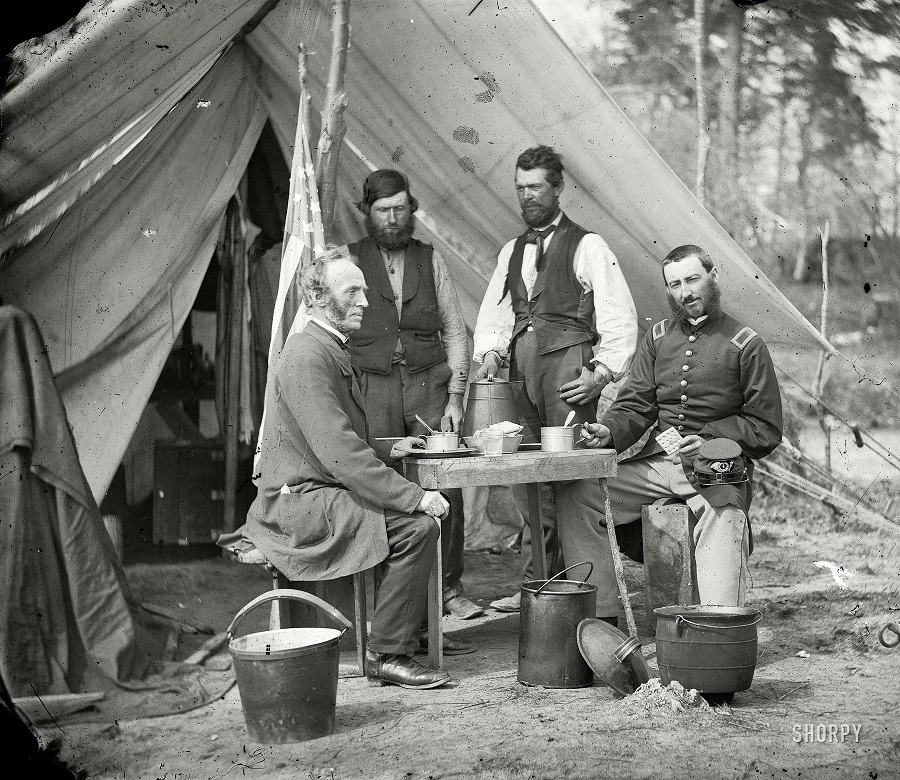
The word ‘coffee’ was used more often in Civil War soldiers’ diaries and letters home than words like ‘war,’ ‘slavery,’ or ‘Lincoln’. Union soldiers often remarked on how often they made coffee, while Confederate soldiers commented on the lack of coffee, discussing and inventing recipes with odd substitutions in order to simulate the taste. Substitutes included whatever could be found and roasted in the field, including chicory, acorns, dandelions, rye, peanuts, and peas.
While coffee certainly didn’t win the war, it played a larger role in the social and economic aspects of the period, influencing generations for years to come.
The Westward Expansion
In the early 19th century, many settlers began to move westward in search of land, gold or other opportunities. Among them were cowboys, who were animal herders who tended cattle on ranches or drove them across long distances. Cowboys faced many hardships and dangers on their journeys, such as hostile Indians, bandits, weather and terrain. They needed a strong and reliable drink to keep them going, and coffee was their choice.
Coffee was an essential part of the cattle drives in the Old West. Cowboys relied on the strong brew to keep them awake and energized during long hours of herding cattle across vast distances. Coffee also provided warmth and comfort in the harsh conditions of the frontier. The chuckwagon, which carried the food and supplies for the cowboys, always had a pot of coffee brewing over the fire.
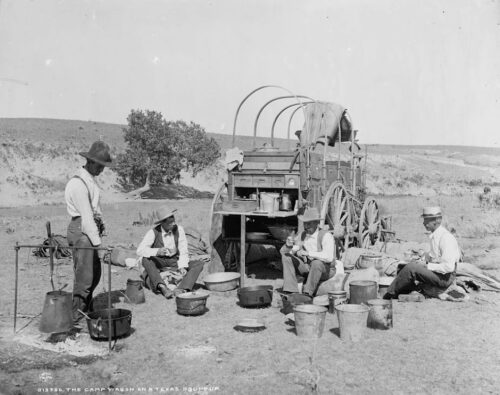
Coffee was served as water with every meal for cowboys. They treated their coffee supply as precious as gold, and they developed a keen sense of taste for different roasts and strengths. They called their weak coffee “dehorned belly wash” or “brown gargle”, while their strong coffee was “black strap.”
Westbound settlers in the 19th century left behind the Eastern cities where they could buy pre-ground coffee. This required them to carry coffee beans with them, even though they added extra weight to their wagons. These beans were green and had to be roasted before they could be used. They had to roast them in a frying pan or over a fire, and then grind them with a handheld device.
Cowboys made their coffee in a pot over an open fire or bed of coals. They brewed their coffee by throwing a handful of grounds into a pot of water and bringing it to a boil. The longer it was boiled the stronger the coffee. And cowboys liked their coffee strong! As the water cooled, most of the grounds sank to the bottom, but some remained floating. To avoid drinking them, cowboys used a variety of methods. One of the most popular ways was to simply add some cold water to make the grounds settle faster. The result was a brew that cowboys loved and figuratively drank by the gallon.
Native Americans in the Old West had a complex relationship with coffee. Some tribes traded with settlers and acquired coffee beans, which they roasted and brewed in their own ways. Other tribes avoided coffee, seeing it as a foreign substance that could harm their health or spirituality. Coffee was also a symbol of the cultural and economic differences between Native Americans and the newcomers who invaded their lands.
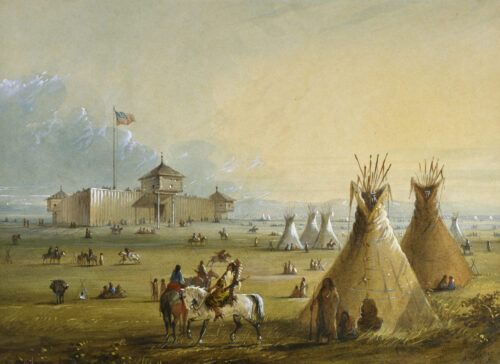
Coffee Pioneers
The process of making coffee was time-consuming and laborious for cowboys and other travelers in the Old West. This created an opportunity for entrepreneurs who wanted to provide them with an easier and faster way to enjoy their favorite drink. One of them was James Folger, who was a young carpenter from Nantucket who came to California during the Gold Rush in 1850. He worked for William Bovee, who owned a spice and coffee mill in San Francisco. Folger traveled to the goldfields with samples of roasted coffee beans sealed in tins, which he sold to miners and storekeepers. He made enough money to buy out Bovee’s business in 1859 and renamed it James A. Folger Company. He became one of the first to sell pre-roasted and pre-ground coffee in the West.
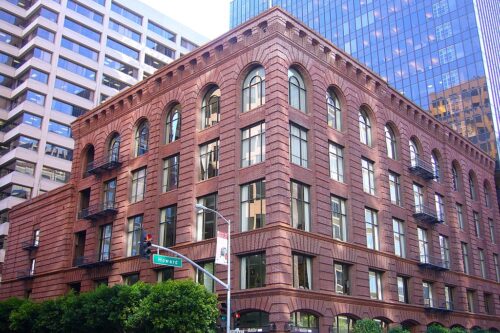
Another pioneer in the coffee industry was John Arbuckle, who was a grocer from Pittsburgh who moved to Texas in the 1860s. He invented a process of coating roasted coffee beans with a mixture of egg and sugar, which preserved their flavor and freshness for longer. He also packaged them in one-pound bags with a peppermint stick as a bonus. He marketed his product as Arbuckle’s Ariosa Coffee, and he distributed it widely across the West by wagon, train and boat. His coffee became so popular among cowboys and ranchers that they often used it as a form of currency or barter. Arbuckle’s coffee was also known for its colorful advertisements, which featured scenes of the Old West and slogans such as “The Coffee that Won the West”.
I never met a man I didn’t like who drank coffee.” — Will Rogers, cowboy philosopher
To Sum Up
Coffee and the Old West have a shared history that reflects the culture and values of the people who lived and worked in that era. Coffee was more than just a drink; it was a source of energy, comfort, socialization and identity. It was also a symbol of freedom, independence and adventure, which are still associated with coffee today. The next time you sip your “Cup of Joe,” remember the cowboys and pioneers who helped make coffee an integral part of the American way of life.
*The views and opinions expressed on this website are solely those of the original authors and contributors. These views and opinions do not necessarily represent those of Spotter Up Magazine, the administrative staff, and/or any/all contributors to this site.

